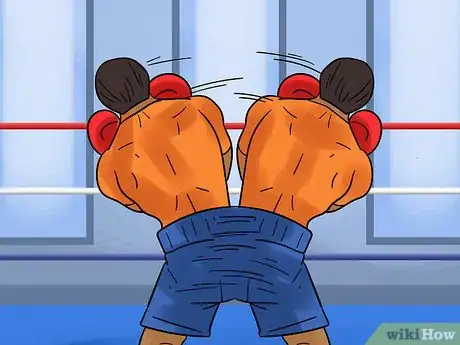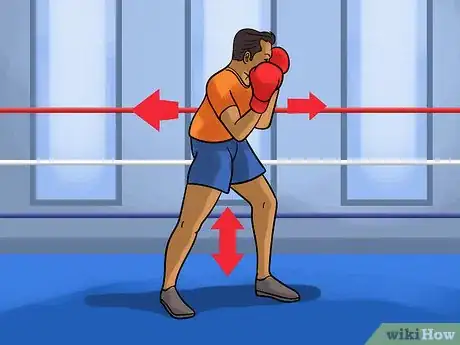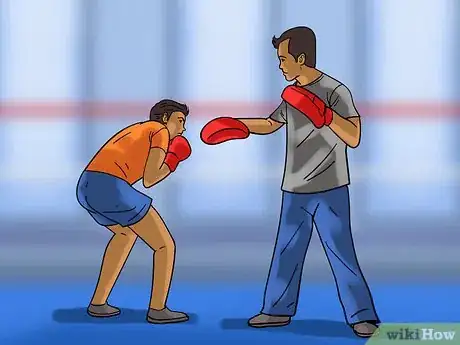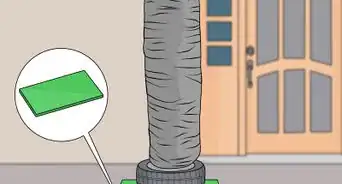This article was co-authored by David Engel. David Engel is a Muay Thai Instructor and Self Defense Trainer based in the San Francisco Bay Area. With over 15 years of martial arts instruction and training experience, David runs California Martial Athletics with co-owner Joe Chernay. He has created and maintained martial arts programs at Rise Combat Sports in San Francisco and Round 5 Martial Arts Academy in San Leandro, with a mission to provide students with a level of comfort and competency that manifests both within and outside the martial arts context. He is also a registered cornerman for amateur and pro competitors under the IKF (International Kickboxing Federation). David was the youngest apprentice instructor of the Thai Boxing Association of America under Ajarn Chai Sirisute (2009), and was a top-ranked amateur competitor in his weight class (127-130 lb) in California between 2013 and 2015.
There are 13 references cited in this article, which can be found at the bottom of the page.
This article has been viewed 138,198 times.
When it comes to protecting yourself in boxing, staying in constant motion is paramount. For this reason, seasoned boxers favor evasive maneuvers over impactful guard blocks and parries. The “bob and weave” technique, which involves leaning and circling with the head while changing the position of the upper body, is one of the cornerstones of a solid boxing defense. Incorporating the bob and weave technique into your defensive tactics will make you harder to hit and help take your skill to the next level.
Things You Should Know
- Bend your knees, tilt your upper body, tuck your chin, and move up and down to bob; weave by using your waist, head, and shoulders to dodge a straight punch.
- Combine the two movements by bobbing consistently and working in several slips until you’re bobbing and weaving.
- Practice stationary drills, add the technique to your shadowboxing session, and set up a rope to approximate the centerline of your opponent’s body.
- Use a bob and weave to counter tall opponents, get in position for counter punches, dazzle opponents, and minimize an opponent’s attack.
Steps
Breaking Down the Technique
-
1Use the knees to “bob.” To perform the bobbing portion of the defense, bend your knees to lower your center of gravity. At the same time, tilt your upper body forward slightly and duck your chin. When done correctly, you should be able to sink low enough for a hypothetical punch to pass clear over the top of your head. After you duck, return quickly to your fighting stance.[1]
- To “bob” means to move up and down rhythmically, which is exactly how ducking is done in the sport of boxing.
- Bend at the knees, not at the waist. Hunching over forces you to take your eyes off your opponent for a split second and leaves you vulnerable to uppercuts and shovel hooks from below.[2]
-
2Learn to "weave" together consecutive slips. As a straight punch comes toward you, use a tight, controlled motion of your waist, head and shoulders to lean out of the way toward the outside of the punch. This way, the punch will “slip” right past. Continue this evasive head movement to slip consecutive punches in combination. Chaining together multiple slips is known as “weaving” because of the repeated side-to-side motion of the boxer’s head.[3]
- Don’t lean too far to the side when slipping punches. A proper slip is a very conservative movement. You should only lean enough to make sure that the punch passes by harmlessly.[4]
- Slipping is an effective defense against straight punches because it doesn’t require you to make contact with the other fighter, and therefore suffer impact, at all.
Advertisement -
3Combine the two movements. Now it’s time to put the “bob” and the “weave” together. Start bobbing again, using the knees and waist to fluidly drop and spring back into an upright position. This time, work in a few slips as you duck and raise up. Since punches are delivered at different heights and angles, it’s critical to learn to duck your head in conjunction with the continued lateral weaving motion of the slip in order to have a strong mobile defense.[5]
- When bobbing and weaving, your head should circle forward and back, side to side while your body moves up and down. This creates a target that eludes punches in three dimensions.[6]
-
4Keep moving. Be ready to bob and weave constantly as you jockey for position, move in and out of punching range or find yourself pushed back on the defensive. The idea is to never stay in the same place for long. As long as your head isn’t in the spot your opponent is aiming, they won’t be able to land a clean shot. Bobbing and weaving is so effective because it keeps your opponent guessing.[7]
- Bobbing and weaving is especially effective when your opponent has you trapped in the corner or pinned against the ropes and you can’t easily move out of his range.
Training to Bob and Weave
-
1Practice stationary drills. Warm up or cool down by practicing bobbing and weaving. Concentrate on making each part of the movement crisp and deliberate. When you’re first getting the hang of it, the bob and the weave should be performed in sequence as two distinct motions. You can begin fine-tuning the movements as you develop a feel for the technique.[8]
- Performing the bob and weave technique requires a lot of head movement. Do some light stretches before you begin practicing to keep from pulling a muscle.
- Bobbing and weaving should be done fluidly and spontaneously. Try not to develop a pattern in your head movement, or your opponent may catch on. For your defense to be successful, it's essential that your opponent does not know where your head is going to be.
- Also focus on exercises that improve your balance and leg strength, like uphill sprints, jump squats, and skipping rope.[9]
-
2Set up a rope. One traditional approach to drilling the bob and weave makes use of a rope to approximate the center line of your opponent’s body. Simply stretch a length of rope (something as basic as a clothesline will work) from end of the room to the other at roughly chest-height. Then, work your way down the line, bobbing down and weaving underneath the rope and standing back up on the opposite side each time.[10]
- Bobbing and weaving with a rope teaches you to move your head while moving forward and backward, the way you would in the ring.
- Throw some quick combinations as you come up on either side of the rope. This will condition you to follow up an evasion with counter punching.
-
3Work with a coach. If you receive regular instruction, ask your coach for some assistance refining your bob and weave defense. They’ll be able to critique your technique, demonstrate new training methods and work with you on the target mitts. One-on-one interaction with a coach will simulate using the technique against a live opponent and provide valuable experience.[11]
- Your coach will gradually increase the intensity of your drills to help condition you for a real match.[12]
- A good coach will also be able to show you how to modify your defensive posture to suit your particular style and body type.
-
4Incorporate bobbing and weaving into your shadow boxing. Add a little bobbing and weaving the next time you cool down with a shadow boxing session. Imagine that you’re sparring with an invisible opponent who has a superior reach, and that you have to continually duck and slip in and out to avoid their punches. Since shadowboxing conditions you to use various punches and defensive movements organically, it’s the perfect testing ground for trying out new techniques like the bob and weave.[13]
- Face a mirror while shadow boxing and try to reflexively dodge punches as you throw them.
- Another benefit of shadow boxing in the mirror is that it allows you to review your form so that you can correct bad habits.
Using the Bob and Weave Defense in the Ring
-
1Counter a taller opponent. If you’re a shorter boxer, or happen to find yourself up against an opponent who towers over you, make bobbing and weaving a key part of your game plan. The technique makes an ideal defense against taller opponents because you’ll already be in a better position to dip underneath their attacks. Making them chase you by forcing them to reach with their punches will also wear them out faster, giving you a twofold advantage.
- After a successful bob and weave defense against a taller opponent, initiate your counterattack while you’re still in range, before your opponent has a chance to retract their punching arm.
-
2Position yourself for counter punches. One of the greatest assets of a good mobile defense is that it delivers you to safety away from your opponent’s attacks while leaving your hands free to respond with counter punches of your own. Weaving outside a jab or straight will set you up to throw a hook in return. Similarly, once you’ve ducked their punch, your opponent’s midsection will be wide open for a punishing body shot.[14]
- Out-angling your opponent is all about situating yourself where they’re vulnerable to your attacks, but theirs can’t reach you. Knowing when and how to weave can help you accomplish this.[15]
- If you're using a bob and weave defense to set up counter punches, make sure your movement does not telegraph your attacks. For example, twisting to put yourself in a better position to throw a counter hook after evading can signal to your opponent that a punch is coming.
- Practice setting up counter punches by bobbing and weaving when you’re working out on the pads or heavy bag.
-
3Dazzle your opponent with superior movement. Infuriate the competition by never holding still. You’ll get less battered than if you constantly absorb punches with your guard, and you’ll always be ready to throw a counter punch. When your opponent discovers they can’t land a shot on you, they’ll become frustrated and start making costly mistakes that you can then capitalize on.[16]
- A good general rule for bobbing and weaving is that you should increase your head movement whenever you're within striking distance. However, that doesn't mean your movement should stop when when you're out of range, as it's likely that either you or your opponent will close the gap suddenly.
- Keep in mind that the more you move, the faster you’ll tire out. Wait until you’re within punching range to bob and weave. It’s an excellent way to make yourself hard to hit, but it can be exhausting if you overdo it.
-
4Roll with the punches. Before it was a common saying, it was an effective boxing defense. Even if you can’t dodge an incoming hook or cross entirely, you can “roll” with the attack and minimize the amount of damage it does. For instance, if you see a right hooking coming and can’t get out of the way in time, bob down and weave to your right so that you’re moving in the direction of the punch and the shot glances off the top of your head.[17]
- Learning to roll in the direction of a punch can be tricky, as you’ll be most likely be used to slipping punches to the outside. Be sure to train slipping in both directions and develop a sense of when an attack can be slipped and when it has to be absorbed.
- By modifying your evasive maneuvers and learning how to roll, you’ll spare yourself a lot of punishment in the later rounds of the fight.
Expert Q&A
-
QuestionHow can I train myself to punch faster?
 David EngelDavid Engel is a Muay Thai Instructor and Self Defense Trainer based in the San Francisco Bay Area. With over 15 years of martial arts instruction and training experience, David runs California Martial Athletics with co-owner Joe Chernay. He has created and maintained martial arts programs at Rise Combat Sports in San Francisco and Round 5 Martial Arts Academy in San Leandro, with a mission to provide students with a level of comfort and competency that manifests both within and outside the martial arts context. He is also a registered cornerman for amateur and pro competitors under the IKF (International Kickboxing Federation). David was the youngest apprentice instructor of the Thai Boxing Association of America under Ajarn Chai Sirisute (2009), and was a top-ranked amateur competitor in his weight class (127-130 lb) in California between 2013 and 2015.
David EngelDavid Engel is a Muay Thai Instructor and Self Defense Trainer based in the San Francisco Bay Area. With over 15 years of martial arts instruction and training experience, David runs California Martial Athletics with co-owner Joe Chernay. He has created and maintained martial arts programs at Rise Combat Sports in San Francisco and Round 5 Martial Arts Academy in San Leandro, with a mission to provide students with a level of comfort and competency that manifests both within and outside the martial arts context. He is also a registered cornerman for amateur and pro competitors under the IKF (International Kickboxing Federation). David was the youngest apprentice instructor of the Thai Boxing Association of America under Ajarn Chai Sirisute (2009), and was a top-ranked amateur competitor in his weight class (127-130 lb) in California between 2013 and 2015.
Muay Thai Instructor & Self Defense Trainer If you can effectively weave away from your opponent's hit, look for an opportunity to strike. Usually after punching, your opponent's shoulder will be down and their chin will be up, making their jaw an open target.
If you can effectively weave away from your opponent's hit, look for an opportunity to strike. Usually after punching, your opponent's shoulder will be down and their chin will be up, making their jaw an open target. -
QuestionWhat exercises can I do to get better at bobbing and weaving?
 David EngelDavid Engel is a Muay Thai Instructor and Self Defense Trainer based in the San Francisco Bay Area. With over 15 years of martial arts instruction and training experience, David runs California Martial Athletics with co-owner Joe Chernay. He has created and maintained martial arts programs at Rise Combat Sports in San Francisco and Round 5 Martial Arts Academy in San Leandro, with a mission to provide students with a level of comfort and competency that manifests both within and outside the martial arts context. He is also a registered cornerman for amateur and pro competitors under the IKF (International Kickboxing Federation). David was the youngest apprentice instructor of the Thai Boxing Association of America under Ajarn Chai Sirisute (2009), and was a top-ranked amateur competitor in his weight class (127-130 lb) in California between 2013 and 2015.
David EngelDavid Engel is a Muay Thai Instructor and Self Defense Trainer based in the San Francisco Bay Area. With over 15 years of martial arts instruction and training experience, David runs California Martial Athletics with co-owner Joe Chernay. He has created and maintained martial arts programs at Rise Combat Sports in San Francisco and Round 5 Martial Arts Academy in San Leandro, with a mission to provide students with a level of comfort and competency that manifests both within and outside the martial arts context. He is also a registered cornerman for amateur and pro competitors under the IKF (International Kickboxing Federation). David was the youngest apprentice instructor of the Thai Boxing Association of America under Ajarn Chai Sirisute (2009), and was a top-ranked amateur competitor in his weight class (127-130 lb) in California between 2013 and 2015.
Muay Thai Instructor & Self Defense Trainer Good bob and weave comes from having strong legs and good balance, so do exercises like jump squats and uphill sprints. In addition, jumping rope is crucial for improve your balance and defense.
Good bob and weave comes from having strong legs and good balance, so do exercises like jump squats and uphill sprints. In addition, jumping rope is crucial for improve your balance and defense.
References
- ↑ http://www.mightyfighter.com/how-to-bob-and-weave/
- ↑ http://www.mightyfighter.com/how-to-bob-and-weave/
- ↑ http://www.expertboxing.com/boxing-techniques/defense-techniques/how-to-slip-punches-in-boxing
- ↑ http://www.mightyfighter.com/how-to-slip-punches/
- ↑ http://www.dailymotion.com/video/xe7h1m_bob-and-weave-like-a-boxing-pro_sport
- ↑ http://www.expertboxing.com/boxing-techniques/defense-techniques/boxing-head-movement
- ↑ http://www.mightyfighter.com/how-to-bob-and-weave/
- ↑ http://www.myboxingcoach.com/bob-and-weave-roll-with-em/
- ↑ David Engel. Muay Thai Instructor & Self Defense Trainer. Expert Interview. 5 May 2020.
- ↑ https://www.youtube.com/watch?v=z4dU2Z0EbnI
- ↑ https://www.youtube.com/watch?v=Qel79X1SVjU
- ↑ David Engel. Muay Thai Instructor & Self Defense Trainer. Expert Interview. 5 May 2020.
- ↑ https://www.myboxingcoach.com/shadow-boxing/
- ↑ http://www.mightyfighter.com/how-to-bob-and-weave/
- ↑ http://www.expertboxing.com/counter-punching
- ↑ http://www.expertboxing.com/boxing-techniques/defense-techniques/boxing-defense-techniques
- ↑ http://dearsportsfan.com/2015/09/24/what-does-it-mean-to-roll-with-the-punches/
About This Article
To bob and weave in boxing, start by bending your knees so you can bob up and down. You want to be able to sink low enough that a punch from your opponent could pass over your head. Then, continue leaning from one side to the other with your waist, head, and shoulders so an opponent's punch would slip past you. As you're boxing, bob and weave continuously, which will make it harder for your opponent to accurately aim a punch at you. For tips on how to practice your bobbing and weaving, scroll down!





































































